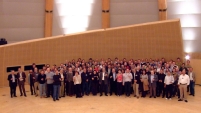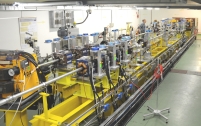 |
 |
|||||||||||||
|
|||||||||||||
|
|||||||||||||
|
The ILC-CLIC (International Linear Collider - Compact Linear Collider Study) collaboration was started earlier this year at CERN. It consists of five working groups which are led by conveners from both projects. Collaboration mandates and activities were defined with an eye toward this autumnís workshops: the CLIC08 workshop, held at CERN from 14 to 17 October and the ILC-LCWS08, to be held in the middle of next month in Chicago. CLIC08 was the first time the group met face to face since the collaboration and its working groups were established. The collaboration is intended to serve two basic purposes: firstly to allow a more efficient use of resources, especially engineers, and secondly to promote communication between the two project teams. Of course, face-to-face meetings tend to be more effective than tele-conferencing, so many excellent opportunities for direct, informal, discussion arose between the two teams and we made good progress toward our second purpose. Since the framework of the meeting was the CLIC08 workshop, the agenda naturally focused on CLIC challenges and plans with specific collaboration highlights having a key, but minor overall role.
Foremost among CLIC topics are the development of the two beam - CLIC accelerator module and plans of a future system test facility, which are just now in very early stages of discussion, The CLIC module design details provided a perspective, especially for attendees from the ILC side of the collaboration, which showed the tight mechanical positioning and structure tolerances of the high-frequency, high-gradient machine. In addition, precision components of the module require cooling water of just the right temperature and flow. While ILC cooling requirements are different, the two projects have a common requirement for large and apparently relatively expensive cooling systems. Work on this topic is one place where we hope to achieve substantial efficiency through collaborative use of specialised engineering resources. This meeting saw the analysis of the lessons to be learned in the system test facility, 'CTF3' presently under completion and the unveiling of plans for a possible new 6.5-GeV two-beam system test facility in the future. Many of the issues facing the ILC team who work with the four ILC system test facilities - are present with this new CLIC test facility also. It will be a challenge for us all to make sure we use resources effectively to build test facilities that are both convincing and effective demonstrations of the technology and scientific instruments in their own right. One of the biggest jobs for the CLIC team, as it was also for the ILC Reference Design Report team, is the development of a reliable costing methodology. The ILC value estimate from the RDR has been reviewed by an international committee under the guidance of the International Linear Collider Steering Committee (ILCSC) and FALC (Funding Agencies for Large Colliders), and the CLIC team have agreed to try to develop their costing using a similar basis. The two machines have much in common, sometimes sharing specific components, for example the optics design of the beam delivery system, but there are also big differences. The most important of these is cultural and arises through the strongly CERN-centred nature of the CLIC project team in contrast to the intrinsically diverse, global ILC Technical Phase Design team. The Cost and Schedule Working Group was established in order to provide a common costing methodology between the two projects. Such a standardised basis should facilitate the evaluation and review process of each project. The Cost and Schedule Working Group mandate, indicating what should be reported at the 2008 autumn workshops, lists the development of a common component 'cost-input' form and a recommendation on analysis and report-generating software. Neither of these tasks is simple, especially as there are tools and systems already in place at CERN and within the ILC costing team. At CLIC08 the group reported that discussions had started but that they still had a lot to do before coming to a functioning consensus. -- Marc Ross |
|||||||||||||
| © International Linear Collider |

